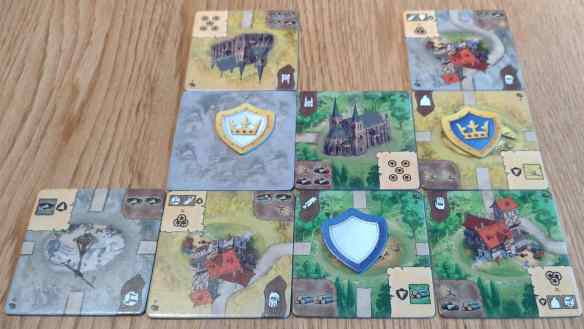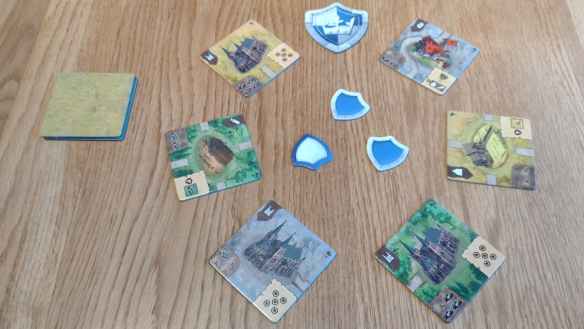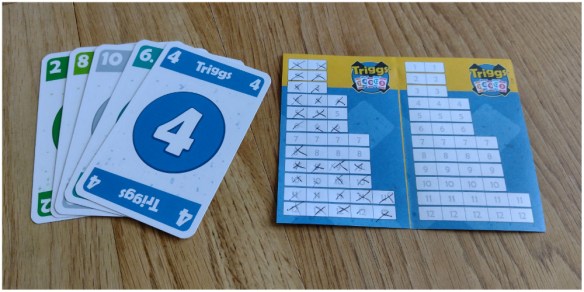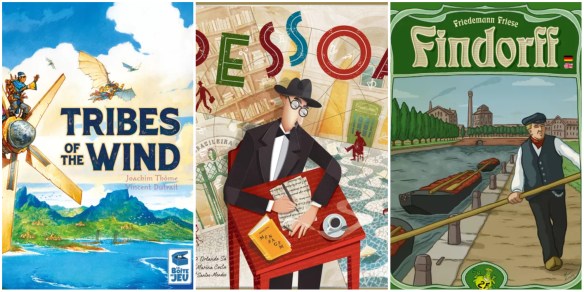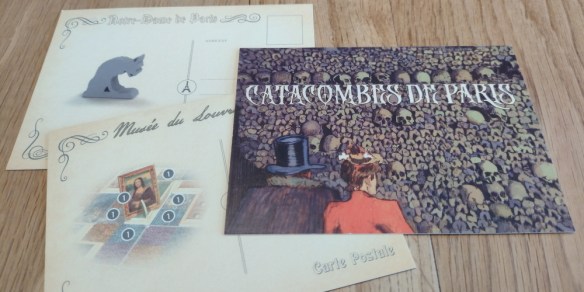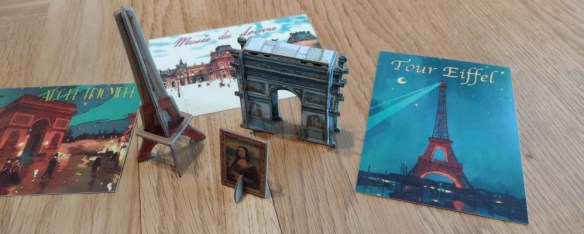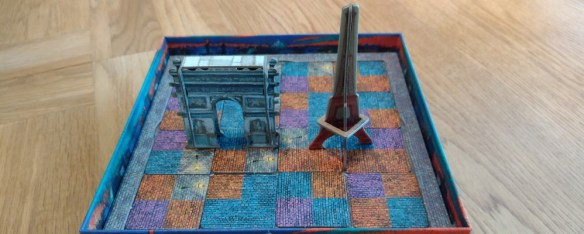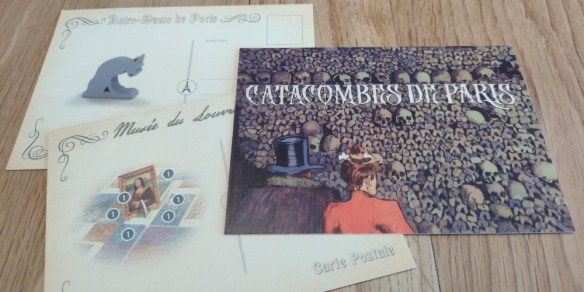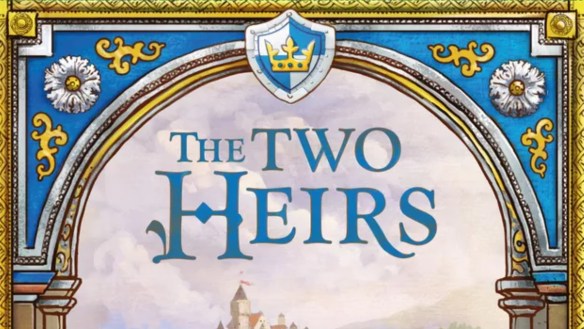
The Two Heirs board game is a one or two-player tile-laying game that takes around 30-60 minutes to play. The box suggests an age range of 10-plus, which feels about right. Thematically you play as two heirs vying to take your father’s throne by proving you’re the better ruler. You do this by laying tiles into a shared area, attempting to score points from your placed tiles while cutting off opportunities for your opponent.
Related: Essen Spiel 2022: Reviews incoming
In the box, you’ll find 54 cardboard tiles, 18 cardboard chits, and a scorepad. The tile art is as nice as the rather ordinary theme will allow, and the iconography is clear. It looks nice if unspectacular on the table, and needs a little more space to play than the short component list might suggest. The tiles are 6x6cm and you have no idea in what shape your tile area may end up. Looking at comparison site Board Game Prices, you can find it for around £20 but unfortunately, it is not currently available in the UK. At £20, it offers pretty good value.
Teaching the Two Heirs board game
The Two Heirs is simple to teach. It has largely face-up information, so it is easy to step in with advice or clarifications and the few tiles a player may have in hand will always have been seen when picked up, so even then there’s there is no need to be secretive. Players take turns taking a tile (mandatory) before playing as many tiles as they like, or can, from their hand to the shared play area (the hand limit is three). Each game uses 27 tiles and ends when the available stock of six can no longer be replenished, as the draw pile is empty.
Twenty-seven tiles are shuffled into a draw deck, with one placed face down in the middle of the play area as starting tile (each tile has one of three terrain types on the back). Six tiles are placed face-up in a circle, along with the Royal Shield token. The shield represents the one point of ‘reach’ players are always guaranteed on the circle, while also being the start point from which a player can choose tiles (clockwise) around the circle.
Each player starts with two soldier tokens within the circle and one on the start tile. The two in the circle can be moved to empty tiles in the play area, and back to the circle, but the one out on the board must always stay there. Once one player has moved their soldier from the start spot, no two soldiers can ever be on the same tile again. Each of your soldiers can only be moved once per turn and a soldier can occupy any tile it can get to (each can move one space per turn).
making and placing tiles
To take a tile you count your soldiers in the circle, add one for the shield, and take a tile with that number clockwise from the shield. Remember, you can bring soldiers back from the table to the circle if required. To play tiles, you have two choices. You can play a tile face down for free, or pay a tile face up for its cost. This cost will be up to four resources. The resources available to you are those within reach in the circle, plus any on the board your soldiers occupy (tiles you’ve already placed may offer bonus resources). Again, you may be able to move unmoved soldiers to make up for any shortfall.
Tiles placed face-up need to face you, as most will score you points at the end of the game. all tiles must be placed orthogonally to at least one already on the board, but have no other matching requirements, even if they have roads on them. Most tiles score differently, with a large variety of options available. And any of your tiles with one of your soldiers on it at the end of the game will score double. The player with the most points wins.
The four sides
These are me, plus three fictitious players drawn from observing my friends and their respective quirks and play styles.
- The writer: Visually this is a hard game to love, due to the drab theme and overall beigeness. But it sets up fast, plays smoothly, and offers a lot more interesting choices than you’d expect. It builds tension nicely too, as you hope your opponent misses your master plan. It’s a shame scoring takes so long, but the scorepad helps. And it is worth it, as the game wouldn’t be as good without the variety that makes it such a pain to add up.
- The thinker: What looks quite simple is in fact quite the brain teaser. There are many moving parts for so few components. With just nine terrains of each colour, it is simple to keep track of what has and hasn’t appeared. Although parsing all the scoring opportunities can get a little much. A bad tile order early on can make for a tedious beginning to the game. But otherwise, I have very much enjoyed my plays of The Two Heirs.
- The trasher: It’s rare that a game tries to be both puzzley and interactive, but this one gets the mix just about right. Better still there is plenty of variety in the box, with six sets of nine tiles, and only half of the sets are used each game. some are actually viscous, allowing you to remove the opponent’s tiles. But even without those, you’re always having to think whether a block or a points play is going to work out for the best. A surprise hit.
- The dabbler: I quite enjoyed The Two Heirs board game but it took a whole game to win me over. While the tiles have pretty art, it’s so brown and boring looking. And the volume of icons is baffling at first. But, once we got going, I found myself enjoying it. That said, the boring theme and presentation meant I soon forgot about it. I’d happily play it some more.
Key observations
Unfortunately, The Two Heirs board game made nary a ripple at Essen 2022. A the time of writing it has just 36 ratings on Board Game Geek and only 13 comments. Publisher Albi is only now making inroads into the hobby market, which isn’t good news for the game. And I can only hope it somehow manages to get a bit of a push, as I feel it deserves one. Sure, the market for bland-looking two-player tile-laying games probably isn’t huge. But it is certainly bigger than the reach it has managed so far. I agree with the few comments it does have. Lots of interesting choices in a constantly shifting arena, only really let down by some slightly suspect production and symbology.
As for the solo version, it adds a whole other layer to the puzzle. You play a two-player game against a basic AI opponent. However, its simplicity means you can think about what move the AI will do depending on the tile you take, and where you place it. This is hugely AP-inducing, but as that’s what a lot of solo gamers want I can see it being a big hit. If you like solo puzzle games, I’d certainly suggest you take a look.
Conclusion: The Two Heirs board game
The Two Heirs is an excellent two-player abstract puzzle game with an impressive solo variant. It is highly competitive, either passively or also aggressively depending on which tiles you use. Highly recommended and a definite keeper.
- Thanks to Albi for providing a copy for review.
- Follow this link for 200+ more of my board game reviews.

